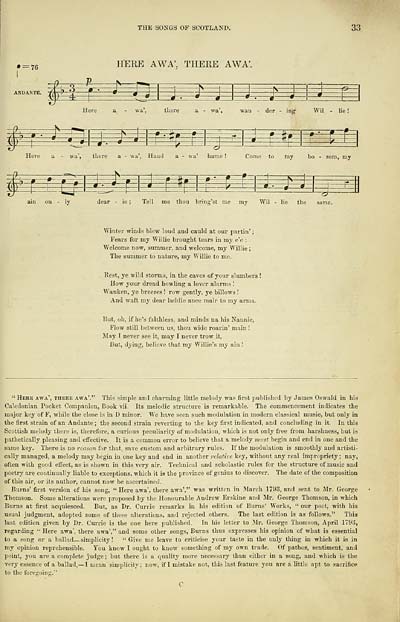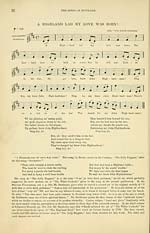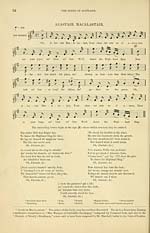Glen Collection of printed music > Printed music > Wood's edition of the songs of Scotland
(57) Page 33 - Here awa', there awa'
Download files
Complete book:
Individual page:
Thumbnail gallery: Grid view | List view

THE SONGS OF SCOTLAND.
33
• = 76
HERE AW A', THERE AWA
£#=r*
W^k
:p
•=izzi:
I
Here a - wa', there a - wa', wan - der - ing- Wil - lie !
^
T—r
«E
F=^:
# •
=P=£
Plere a - wa', tliere a - wa', Hauil a - wa' hame ! Come to my bo - som, my
£
ifi^E
£=*=
3=F
W
ain on - ly dear - ie ; Tell me thou bring'st me my Wil - lie the
Winter winds blew loud and oauld at our partin' ;
Fears for my Willie brought tears in my e'e :
Welcome now, summer, and welcome, my Willie ;
The summer to nature, my Willie to me.
Rest, ye wild storms, in the caves of your slumbers !
How your dread howling a lover alarms !
Wauken, ye breezes ! row gently, ye billows !
And waft my dear laddie ance mair to my arms.
But, oh, if he's faithless, and minds na his Nannie,
Flow still between us, thou wide roarin' main !
May I never see it, may I never trow it,
But, dying, believe that my Willie's my ain !
" Here aw a', there awa'." This simple and charming little melody was first published by James Oswald in his
Caledonian Pocket Companion, Book vii. Its melodic structure is remarkable. The commencement indicates the
major key of F, while the close is in D minor. We have seen such modulation in modern classical music, but only in
the first strain of an Andante ; the second strain reverting to the key first indicated, and concluding in it. In this
Scottish melody there is, therefore, a curious peculiarity of modulation, which is not only free from harshness, but is
pathetically pleasing and effective. It is a common error to believe that a melody mvst begin and end in one and the
same key. There is no reason for that, save custom and arbitrary rules. If the modulation is smoothly and artisti-
cally managed, a melody may begin in one key and end in another relative key, without any real impropriety ; nay,
often with good effect, as is shown in this very air. Technical and scholastic rules for the structure of music and
poetry are continually liable to exceptions, which it is the province of genius to discover. The date of the composition
of this air, or its author, cannot now be ascertained.
Burns' first version of his song, " Here awa', there awa'," was written in March 1793, and sent to Mr. George
Thomson. Some alterations were proposed by the Honourable Andrew Erskine and Mr. George Thomson, in which
Burns at first acquiesced. But, as Dr. Currie remarks in his edition of Burns' Works, " our poet, with his
usual judgment, adopted some of these alterations, and rejected others. The last edition is as follows." This
last edition given by Dr. Currie is the one here published. Iu his letter to Mr. George Thomson, April 1793,
regarding " Here awa", there awa'," and some other songs, Burns thus expresses his opinion of what is essential
to a song or a ballad— simplicity ! " Give me leave to criticise your taste in the only thing in which it is in
my opinion reprehensible. You know I ought to know something of my own trade. Of pathos, sentiment, and
point, you are a complete judge ; but there is a quality more necessary than either in a song, and which is the
very essence of a ballad, — I mean simplicity; now, if I mistake not, this last feature you are a little apt to sacrifice
to the foregoing."
C
33
• = 76
HERE AW A', THERE AWA
£#=r*
W^k
:p
•=izzi:
I
Here a - wa', there a - wa', wan - der - ing- Wil - lie !
^
T—r
«E
F=^:
# •
=P=£
Plere a - wa', tliere a - wa', Hauil a - wa' hame ! Come to my bo - som, my
£
ifi^E
£=*=
3=F
W
ain on - ly dear - ie ; Tell me thou bring'st me my Wil - lie the
Winter winds blew loud and oauld at our partin' ;
Fears for my Willie brought tears in my e'e :
Welcome now, summer, and welcome, my Willie ;
The summer to nature, my Willie to me.
Rest, ye wild storms, in the caves of your slumbers !
How your dread howling a lover alarms !
Wauken, ye breezes ! row gently, ye billows !
And waft my dear laddie ance mair to my arms.
But, oh, if he's faithless, and minds na his Nannie,
Flow still between us, thou wide roarin' main !
May I never see it, may I never trow it,
But, dying, believe that my Willie's my ain !
" Here aw a', there awa'." This simple and charming little melody was first published by James Oswald in his
Caledonian Pocket Companion, Book vii. Its melodic structure is remarkable. The commencement indicates the
major key of F, while the close is in D minor. We have seen such modulation in modern classical music, but only in
the first strain of an Andante ; the second strain reverting to the key first indicated, and concluding in it. In this
Scottish melody there is, therefore, a curious peculiarity of modulation, which is not only free from harshness, but is
pathetically pleasing and effective. It is a common error to believe that a melody mvst begin and end in one and the
same key. There is no reason for that, save custom and arbitrary rules. If the modulation is smoothly and artisti-
cally managed, a melody may begin in one key and end in another relative key, without any real impropriety ; nay,
often with good effect, as is shown in this very air. Technical and scholastic rules for the structure of music and
poetry are continually liable to exceptions, which it is the province of genius to discover. The date of the composition
of this air, or its author, cannot now be ascertained.
Burns' first version of his song, " Here awa', there awa'," was written in March 1793, and sent to Mr. George
Thomson. Some alterations were proposed by the Honourable Andrew Erskine and Mr. George Thomson, in which
Burns at first acquiesced. But, as Dr. Currie remarks in his edition of Burns' Works, " our poet, with his
usual judgment, adopted some of these alterations, and rejected others. The last edition is as follows." This
last edition given by Dr. Currie is the one here published. Iu his letter to Mr. George Thomson, April 1793,
regarding " Here awa", there awa'," and some other songs, Burns thus expresses his opinion of what is essential
to a song or a ballad— simplicity ! " Give me leave to criticise your taste in the only thing in which it is in
my opinion reprehensible. You know I ought to know something of my own trade. Of pathos, sentiment, and
point, you are a complete judge ; but there is a quality more necessary than either in a song, and which is the
very essence of a ballad, — I mean simplicity; now, if I mistake not, this last feature you are a little apt to sacrifice
to the foregoing."
C
Set display mode to: Large image | Transcription
Images and transcriptions on this page, including medium image downloads, may be used under the Creative Commons Attribution 4.0 International Licence unless otherwise stated. ![]()
| Special collections of printed music > Glen Collection of printed music > Printed music > Wood's edition of the songs of Scotland > (57) Page 33 - Here awa', there awa' |
|---|
| Permanent URL | https://digital.nls.uk/91338427 |
|---|
| Description | Scottish songs and music of the 18th and early 19th centuries, including music for the Highland bagpipe. These are selected items from the collection of John Glen (1833 to 1904). Also includes a few manuscripts, some treatises, and other books on the subject. |
|---|
| Description | The Glen Collection and the Inglis Collection represent mainly 18th and 19th century Scottish music, including Scottish songs. The collections of Berlioz and Verdi collected by bibliographer Cecil Hopkinson contain contemporary and later editions of the works of the two composers Berlioz and Verdi. |
|---|

